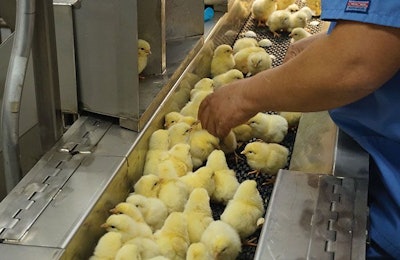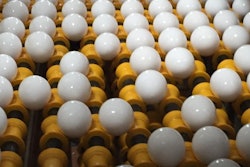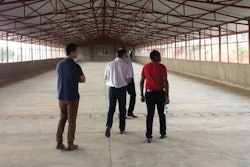
Biosecurity and technology are at the heart of Hendrix Genetics’ new hatchery facility near Grand Island, Nebraska.
The $18 million facility opened in August 2017 and hatched its first eggs in September 2017. The hatchery will supply chicks for 10 percent of the US layer market and is already shipping birds as far away as Arizona and Michigan, Bruce Brown, Hendrix’s location manager said.
The hatchery is designed to serve markets west of Hendrix’s existing hatchery operations in Virginia and Pennsylvania. Currently, it’s supplied by nine contract breeder farms in the vicinity of the hatchery. Hendrix General Manger Doug Metzler said two more farms are expected to be built in 2018. The Grand Island location’s annual production capacity is about 24 million female chicks per year.
Biosecurity as a bedrock of the business
Metzler said biosecurity is a key to the company’s ability to deliver a quality product reliably, so it’s at the center of their business and at the core of the Grand Island hatchery’s design.
“Biosecurity in general is a business preservation and insurance policy of sorts. You do everything you can to prevent something from destroying the business that you worked very hard to build,” Metzler said. “It’s not only us and the investment we have there, but we also consider it very important to make sure that our customers can appreciate the same disease-free product that they expect to receive every time.”
The facility uses segregation of workers, filtration of air and water and a shower-in-shower-out policy to protect the eggs and chicks from disease. Luis Soto, Hendrix’s hatchery manager, said the facility is organized into dirty and clean areas. Workers don’t move from one side to another.
The clean area is where the fertilized eggs are received, stored and incubated. The dirty area is where chicks are hatched, sorted, vaccinated and prepared for shipment to layer farms around the country. The hatchery’s two sides are divided by a corridor designed to keep the operations separate which doubles as a storage location for disinfectants and cleansers used in the operation. The hatchery’s offices are also partitioned off to bolster biosecurity.
All employees who enter into the hatchery and could come in contact with chicks or eggs are required to shower in and out. Employees are issued scrubs to wear inside the facility. Soto said the hatchery even purchased industrial strength washing machines to keep the workwear clean. Metzler said shower in shower out is also used at all Hendrix breeder farms.
Air and water purification
Filtration of air and water is also used extensively. Metzler said all water in the hatchery is reverse osmosis filtered to remove impurities and all air flowing into the facility is clean.
Soto said an on-site water distiller is used to purify water used on chick sprays applied after sorting and before transport. Distilled water is beneficial, he said, because it removes contaminants that could be ingested by the chick.
The building is ventilated so only fresh, clean air flows in. Dirty air is exhausted to prevent it from flowing back inside. Metzler said all air coming into the building is filtered through different types of filters depending on the scenario. Air is pumped through the building using several industrial air conditioning units. Soto said fresh air, along with clean water and sanitary chemicals, helps maintain a clean environment. Fresh air, he said, is a natural disinfectant.
Avian influenza’s influence on site location, biosecurity procedure
Hendrix wasn’t affected by the 2015-2016 avian influenza outbreak that killed 39 million layer hens and rocked the egg and turkey industries in the upper Midwest. Metzler said the disease’s toll is a reminder those threats exist and constant vigilance is necessary.
The outbreak’s location was critical to site selection, Metzler said, as it informed the company where not to locate. Grand Island made sense because of its distance from commercial poultry operations as well as its central location in the country and interstate access. Additionally, Metzler said avian influenza reinforced the existing policy of keeping breeder operations and hatcheries at least six miles away from any other commercial poultry facilities.
New facilities allow increased energy efficiency
Metzler said modern design allowed for recapture and reuse of energy generated in the incubators. Instead of that heat being pumped out of the building – and wasting the energy needed to create it – it is used to reheat water reused inside the hatchery.
In traditional hatcheries, Metzler said, warm air is exchanged in the incubators in order to keep the oxygen level up. Most of the hot air was expelled directly outside. In the new facility, the air is recaptured before it’s exhausted to maintain warm water without additional energy inputs.
Automation and new technology at work
Along with automating tasks like separating the chick from the egg shell, vaccination and beak trimming, the facility makes use of new technology for moving eggs and chicks and managing the incubators.
Soto and Metzler said plans call for installing two robots – built by Hatchery Planning Company – to work in the most labor intensive and injury prone jobs at the hatchery. When installed, the robots will move eggs from receiving pallets onto carts and moving trays with chicks then placing them onto the separator. This will reduce the need for human labor in these repetitive jobs.
The hatchery’s Jamesway Platinum 2.0 model single-stage incubators and the entire facility utilize advanced software to automate the hatching process and manage the environment. Software links all of the incubation equipment and controls the environment within the machines. The software monitors and controls the temperature, humidity, carbon dioxide levels, turning of the eggs.
After hatching and sorting, the Novatech PSP beak trimming and vaccination device is employed to treat multiple chicks at a time. It’s the only machine still used in Europe and approved by European animal welfare standards. Metzler said the device allows for the most consistent vaccination and beak trimming.

















